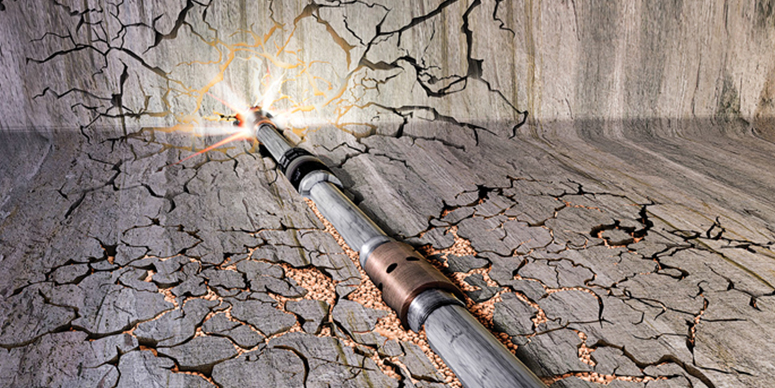The surge in unconventional completions has created a substantial accumulation of previously hydraulically fractured wells that are candidates for hydraulic refracturing. Completion diagnostics are a valuable tool in determining the most cost-effective stimulation and completion parameters, part of the refracturing optimization process. Refracturing allows the operator to capitalize on this continuous improvement in stimulation design. It also provides an excellent opportunity to add incremental production.
Introduction
The primary purpose of refracturing is to increase production from an existing wellbore through stimulation of new rock and the re-establishing of conductive pathways between the reservoir and wellbore. This paper analyzes diagnostic results for a variety of wells in restimulated formations around the country (data for all 69 wells restimulated in 11 formations are provided in the complete paper). This analysis process illustrates that all formations are unique and need to be evaluated independently. What works well in one area often does not apply in other areas because of reservoir differences along with pressure and temperature variances.
Diagnostics
Proppant Tracers
The primary diagnostic technique discussed in this paper is proppant tracing, using three distinct low-level gamma-emitting tracers: iridium-192, scandium-46, and antimony-124. The tracers are pumped primarily throughout the proppant laden portion of the stimulation. A spectral gamma ray logging tool is run to identify near- wellbore proppant placement of each individual tracer. The proppant tracers are ceramic beads, typically 40/70 mesh. The specific isotopes fall in a sweet-spot of half-lives that make them ideal for this application. Through the years, production-log data have shown an excellent correlation with near-wellbore proppant placement, and this same strong correlation exists with traced refracturing.
In initial fracturing operations, proppant-tracing technology can be very useful in addressing the questions of unstimulated perforation clusters, proppant coverage across the lateral, and cluster and stage spacing. It can also be used to highlight possible fracture geometry changes by looking at the nearwellbore signature (transverse or longitudinal) of the three distinct tracers. For multiwell projects, proppant tracers can be an excellent tool to measure offset proppant communication directly.
Offset-Communication Analysis
Recent studies have shown that early interwell communication does not necessarily correspond to long-term communication. Surface-pressure and water-production changes are two observed indicators of offset communication. Though a pressure response in an offset well is an indication of fracture pressure communication, it does not definitively indicate a well-connected fracture system. Similarly, increases in water production can represent recovery of the well’s newly displaced fracturing fluid instead of fluid from an offset. To determine effective drainage areas and optimized well spacings adequately in both initial and refracture completions, it is critical to evaluate the magnitude, duration, and type of communication observed.
Fluid-tracer technology has been used extensively in new completions to profile fracturing-fluid and hydrocarbon recoveries, and it is often used to quantify interwell communication. Its use as a refracturing diagnostic tool is relatively new and primarily focuses on determining the created refracturing geometry and the effective drainage area. When run in conjunction with proppant tracers, it allows a time-lapse image of any offset “fracture hits.”
Hydrocarbon tracers in conjunction with proppant and fluid tracers can play a critical role in addressing these offset-communication questions. They offer the opportunity to obtain a direct measurement of the communication and of the type of overall hydrocarbon drainage area that is being developed (e.g., how much of the reserves are being shared).
The Refracturing Process
Candidate Selection
Developing a master list of available wellbores and then grading or ranking candidates by key criteria can improve overall project economics significantly. One of the best criteria to use initially is any large unstimulated area identified by original completion diagnostics.
It is important to have a strategy in place to test and confirm (diagnostically) conceptual ideas early in the refracturing program. This will allow operators to accelerate the optimization process and ultimately gain sufficient knowledge to “get it right the second time.” One past mistake was restimulating an insufficient number of wells with little to no evaluation data and then abandoning the program before it had been tested adequately.
Another common error is to manage expectations for a refracturing program improperly. If the operator does an effective job of selecting the best candidates, then one should expect some reasonable percentage of the original completion initial productivity and estimated ultimate recovery (EUR). Typically, poor wells cannot be transformed into good wells by the restimulation process.
Perforation/Completion Design
The primary goal of restimulation is to contact new rock. Most operators are adding new perforations in an attempt to have the refracturing initiate at different points along the wellbore. Proppant tracers are used to determine what percentages of the new perforations are being stimulated relative to the existing perforations.
Developing an effective perforation strategy is critical to maximizing overall proppant coverage. The majority of the operators performing refracturing are placing perforations along the entire lateral. Unfortunately, this data suggest that approximately 2,300 ft is the longest interval that can be restimulated consistantly; the challenge is avoiding the preferential treatment of the heel. Several operators are now considering the use of high-energy propellant-assisted perforating in the toe interval to increase the likelihood of more-effective proppant coverage. Another technique that has been used is initially perforating the toe half of the lateral.
Diversion
Operators are using a multitude of diversion techniques to avoid restimulating the same rock as the original completion. Some operators have elected to use mechanical techniques to semipermanently isolate the existing perforations with cement, casing patches, coiled tubing, or liners. This provides maximum flexibility for the number of stages and stage spacing; however, it involves some additional costs, mechanical risks, and possible fracture-rate limitations. It also potentially abandons any existing production unless remedial work is performed to remove the isolation.
Other operators are using nonmechanical temporary isolation techniques such as biodegradable ball sealers or polymers. These methods typically are not definitive isolation techniques, but offer a cost-effective approach to alter the stimulation path. The majority of these products are designed to degrade with temperature and pressure. The goal of this diversion technique is to force the fracture to go to a new, unstimulated region.
However, the analysis of the data indicates that new rock is seldom being contacted after diversions. Anecdotal evidence from a small data set of wells indicates that proppant slugs are as effective as or more effective than degradable isolation products in generating a surfacepressure increase.
The final method of diversion that is currently being tested within the industry is based on various treatment-design changes such as sand slugs, stacking of multiple complete fracturing jobs, and actual job shutdowns. These methods are likely the most cost-effective and offer minimal risk.
The true challenge is determining how an operator evaluates diversion effectiveness. The simplest diagnostic measurement of diversion effectiveness is monitoring surface-pressure changes; however, the pressure system in the wellbore is complex enough to mask such changes. The reality is that not all diversion is effective.
Natural diversion is a cost-effective option that warrants some consideration. The concept is to achieve the path of least resistance through a clean perforating tunnel or mini-fracture vs. an existing perforation that could have scale buildup, stress changes, and proppant placed during a previous stimulation. This data set supports the theory that new perforations can effectively break down during the treatment even when there are open, partially depleted perforations already in place.
Data Analytics
Diagnostic, completion, stimulation, and production data for the 69 refractures, sorted by completion type, are presented and discussed in the complete paper. For the purpose of this study, multiple diagnostic metrics were captured from wells that used proppant tracers.
Performance Metrics
To compare refracturing success from well to well accurately, basic decline-curve analysis was performed on each well. In all cases, the original maximum monthly rate and EUR were documented and compared with the refracturing maximum monthly rate and EUR. The key to this analysis was consistency using the same economic limits. The primary goal of these EUR calculations was to have a relative comparison of the quality of the refractured completions.
Clusters Stimulated
Determining clusters stimulated is a straightforward process of examining detected gamma rays across a perforated interval. It is normal for given perforation depths to vary from where they are detected, sometimes by as much as 40 ft. In some cases, tracer responses split two clusters; When looking at images from refracturing, it is important to take into account the magnitude of the response, which encompasses footage along the length of the lateral and counts detected.Observation of clusters treated at the heel can give an idea of the near wellbore response that indicates being clearly stimulated.
One recommendation for refracture design is the inclusion of new clusters from the midpoint to the toe, the purpose being to force fracturing fluid toward the end of the lateral. A tradeoff is made between covering gaps in the heel half vs. stimulating deeper footage. Stimulation is difficult to achieve beyond 2,300 ft from the heel.
Near-Wellbore Footage Treated
Calculated near-wellbore footage treated is the number of feet along the wellbore showing a tracer response.
Clearly Stimulated Length From Heel Cluster
A metric derived from the diagnostics is the length clearly stimulated from the heel cluster. The purpose of this metric is to determine the continuous footage treated—essentially, how much of the lateral was stimulated effectively. This differs from the near-wellbore footage treated in that more of the job was likely placed across this clearly stimulatedlength reaching farther a field than just near the wellbore.
Farthest Reach.
In the log images, large intervals that lack tracer deeper than the clearly stimulated length can be followed by clearly stimulated clusters. Thirteen of 41 wells that had multiple proppant tracers pumped exhibit a farthest reach100ft or more beyond their clearly stimulated length.
Summary
The overall refracturing success rate in these 43 horizontal wells was 65%, and only six wells showed minimal incremental reserves from the refracturing. Within the analyzed basins, significant variability in both performance metrics and diagnostic attributes is seen. All of the formations had proppant tracers showing preferential treatment of the heel.


 石油圈
石油圈
